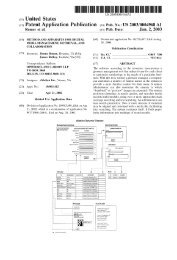Polaroid Corp. v. Eastman Kodak Co. - Oppedahl Patent Law Firm LLC
Polaroid Corp. v. Eastman Kodak Co. - Oppedahl Patent Law Firm LLC
Polaroid Corp. v. Eastman Kodak Co. - Oppedahl Patent Law Firm LLC
Create successful ePaper yourself
Turn your PDF publications into a flip-book with our unique Google optimized e-Paper software.
Intellectual Property Library ISSN 1526-8535<br />
be measured econometrically if all one considers is the demand for low- and mediumrange<br />
cameras. (TR 11193; TR 5103-4). There are not enough years when low- and<br />
medium-priced cameras were available and <strong>Kodak</strong> was not in the market to make the<br />
comparison reliable. So, in order to measure market expansion, Professor Baumol<br />
included high-priced instant cameras. He was thereby able to include the years 1973-<br />
1976 as "0" years and make the statistic reliable. The model therefore compares demand<br />
in two different eras: when low- and medium-range cameras were not in the market and<br />
when they were available. Supposedly, the market expansion variable will not capture<br />
any change in demand due to price, because the price variable will measure that effect. I<br />
believe, however, the dummy variable could be capturing something else entirely: a<br />
change in the marketplace that is not easily quantifiable, - instant photography's<br />
metamorphosis from a sophisticated picture-taking technique for the wealthier buyer or<br />
the photography buff to a fun system accessible to everyone. When <strong>Polaroid</strong> and <strong>Kodak</strong><br />
offered low- and medium-priced cameras, they did more than lower prices; they made<br />
cameras available to more people thereby changing the image of the entire<br />
Page 1504<br />
field. Call it a fad. Call it the development of a mass market. For reasons not having to<br />
do only with <strong>Kodak</strong>, the market changed. Since it changed at the same time <strong>Kodak</strong><br />
entered, the market expansion variable may be capturing this sensation.<br />
While I do not accept these models in this case, I am not critical of the field of<br />
econometrics as a whole. I believe it can provide valuable insight into complicated<br />
matters. However, in this case the models contain assumptions contrary to the facts and<br />
achieve extreme results which by their very nature are suspect. Perhaps the inner<br />
workings of the models, which I cannot fully comprehend, are biased. Perhaps the instant<br />
photography market does not lend itself to mathematical interpretation. Whatever the<br />
reason, I cannot adopt Professor Baumol's model as evidence of market expansion.<br />
<strong>Co</strong>nclusion<br />
But for <strong>Kodak</strong>'s infringement, <strong>Polaroid</strong> had the marketing capability to make most of<br />
<strong>Kodak</strong>'s sales. I find that while <strong>Polaroid</strong> was not capable of making all <strong>Kodak</strong>'s sales in<br />
the premium channel and in some foreign markets, there was nothing unique and critical<br />
to <strong>Kodak</strong>'s entry such that without its infringement, demand would have been diminished.<br />
2. The Market of the Future, According to <strong>Polaroid</strong><br />
Having considered <strong>Kodak</strong>'s claim that the market would shrink without them, I now turn<br />
to <strong>Polaroid</strong>'s claim that without <strong>Kodak</strong> the market would have been more profitable and<br />
would have extended far into the future. <strong>Polaroid</strong>'s case is based, in the first part, on their<br />
assertions that <strong>Kodak</strong>'s behavior in the market forced them to lower their prices and that<br />
without <strong>Kodak</strong>, they would have charged considerably more for their cameras and film.<br />
<strong>Polaroid</strong> also claims they would have introduced the OneStep camera one and one-half to<br />
two years later, allowing them to capitalize on Pronto! sales, produce a better OneStep<br />
and avoid the boom (and therefore, the fall) of instant sales. <strong>Polaroid</strong> uses the<br />
econometric model of Professor Fisher to show how their alternative strategy would have<br />
generated demand for cameras and film which would result in profits of over $3.9 billion<br />
<strong>Co</strong>pyright 2003, The Bureau of National Affairs, Inc. Reproduction or redistribution, in<br />
whole or in part, and in any form, without express written permission, is prohibited except<br />
as permitted by the BNA <strong>Co</strong>pyright Policy. http://www.bna.com/corp/index.html#V<br />
34





